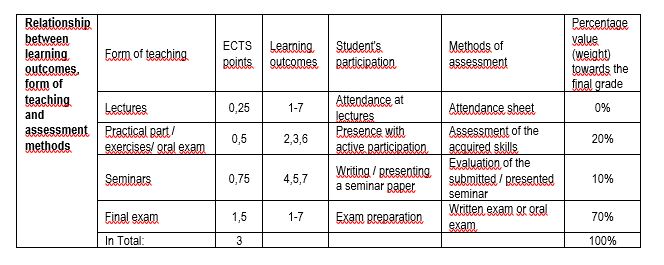The main objective of the course it for student to acquire knowledge and skills in the field of urgent medicine that would enable him better understanding of physiological, pathophysiological and pathological process in the organism, and in accordance with that help him to master the physiotherapeutic procedures that are used in urgent medicine. To allow the student to master the theoretical and practical symptomatology and primary treatment of acute life endangering states and professional medical procedure of the resuscitation of the patient.
The course contains following:
- Life functions and clinical death
- Acute disorders of breathing (drowning, hypothermia, Caisson's disease, heatstroke, electric shock)
- Treatment of polytrauma patient and his scoring – urgent medical help at the event place – pulling out and placement of the patient in adequate position as well as patients’ transport
- Shock caused by loss of blood, plasm, water, and anaphylactic shock.
- Acute disorders of heart function and bloodstream (cardiogenic shock, heart attack, disorders in conduction disorders)
Heart attack –reestablishment and reassurance of life functions
Obavezna literatura:
- Šustić A, ur. Kompendij iz anesteziologije, reanimatologije i intenzivnog liječenja. Rijeka: Digital Point d.o.o.: 2002.
- Včev A, Burton N. Objektivno strukturirano kliničko ispitivanje – OSKI. 1. hrv. izd. Osijek: Medicinski fakultet Osijek; 2015.
Dopunska literatura:
- Safar P. Kardiopulmonalna cerebralna reanimacija. Zagreb: Viša tehnička škola za sigurnost pri radu i zaštitu od požara; 1995
Upon completion of this course, students will be able to:
- Identify urgent medical conditions and symptoms of failure of vital systems of the organism
- Assess the severity of the disease condition and appropriate emergency measures for life-threatening conditions
- Determine the threatening cause of death (suffocation, cardiac arrest, respiratory arrest)
- Valorize the role of the team member in the cardiopulmonary resuscitation procedure
- Compare basic and advanced life support procedures for adults, children and pregnant women
- Select first aid measures and initial care for surgical and trauma patients
- Argue appropriate procedures with respect to the cause, pathophysiological process, and applicable shock protocol



